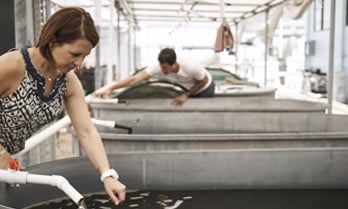







12 October 2020
Moving rivers to restore the lifeblood of communities.
In estuaries throughout the planet, where rivers meet the sea, coastal communities are under pressure. The risk to our estuaries, the lifeblood of many communities is now so great that entire rivers are being moved to give them a second chance to regenerate.
Estuaries are highly sensitive to climate change, as they will be affected not only by changes in processes on land, such as changing river flows due to changes in rainfall, but also changes in marine processes, such as rising sea levels, changes in storminess, and ocean acidification.
Large-scale green engineering is seeing rivers being moved back into estuaries as part of restoring the coastal environment, but we don’t know how they will stand up to climate change. Dr Shari Gallop, Marine Environmental Scientists, wants to understand what makes restoration efforts succeed or fail.
“Estuaries provide an important resource for communities. But many have been degraded due to poor decisions and management, and are vulnerable to climate change because they are exposed to the processes of land, river and marine environments. The ultimate goal is to successfully restore estuaries, to restore the environment for the people.”
Many of the world’s major cities are built around estuaries, including Sydney, New York, Tokyo and London, as well as in New Zealand, such as Auckland and Christchurch. Estuaries, where fresh and sea water mix, provide a population, cultural and economic hub such as by supporting trade through port operations and a globally growing aquaculture industry. Estuaries also support habitats such as salt marsh and mangroves that provide a diverse variety of ecosystem services, such as providing storm protection, supporting unique biodiversity and food sources, sequestering carbon (‘blue carbon’), and connecting with deeply embedded cultural values.
In the past, estuaries and their associated wetlands have sometimes been considered as ‘low value’ and in some cases drained and reclaimed to provide land for farming, housing, and economic infrastructure. Decades to centuries later, these changes have resulted in sometimes catastrophic estuarine degradation due to lost water flows, and a 50% loss of coastal wetlands globally. As the value of estuaries has become recognised, nature-based restoration solutions are being employed, including removing sea walls to allow tides to come back onto reclaimed farmland, removing dams, and moving rivers back into estuaries. The hope is that this will restore these estuaries so they can support economies, food supply and communities.
“We know that people have a strong connection to their environment, and water bodies are critical part of our livelihood and food production. If we don’t do anything some societies could lose their livelihood. We need to fix estuaries because without them, we are going to lose including an important source of cultural identity.”
Shari will investigate the resilience of nature-based estuarine restoration to climate change, and work towards designing estuarine restoration schemes that accounts for the impacts of climate change. This research will provide internationally relevant insights into the resilience of nature-based estuary restoration, ensuring the schemes deliver their environmental benefits such as a healthy, functioning ecosystem alongside providing important spaces where people can connect to nature for many years to come.